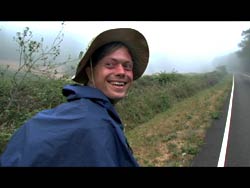Given a choice between importance and obsession, I’ll always bet on the latter as a good documentary subject. In his first film, which premiered at SIFF last year, Seattle-based director/walker Linas Phillips essentially makes the same calculation: Rather than argue on film that his favorite director, Werner Herzog, is a genius, he shoots his own foot-powered pilgrimage from Seattle to L.A. (where Herzog resides), camera usually held at arm’s length framing his own face, trucks whizzing past on Highway 101, braving sunburn and blisters for 1,200 miles to meet a man who might well dismiss him as “a stalker,” as Phillips himself admits. He also admits the stunt is based, in a meta-devotional sort of way, on Herzog’s own 1974 trek from Munich to Paris—an act that Herzog thought would save an ill friend’s life. (For the record, Herzog was quite well during Phillips’ 2005 journey, off filming Rescue Dawn in Thailand.)
Walking to Werner is, in more than one sense, an act of endurance. The doughy, long-haired Phillips is clearly no athlete, but a tenderfoot embarked on an Amazing Race–style expedition we might not reasonably expect him to finish. At the same time, there’s our claustrophobic witnessing of his many roadside soliloquies—something like Richard Lee’s public-access TV show Kurt Cobain Was Murdered. This forced intimacy is by turns fascinating, repellent, and comical. Still, we watch; and still, he marches on. Saving us from tedium, however, Phillips has the good sense to occasionally put the camera on the tripod and open up Werner into a panoramic road movie. He also gains access to DVD commentaries featuring the voice of Herzog—along with Scarecrow Video’s Norm Hill, who eventually gets the director to leave cell phone messages for Phillips en route. Whining and dorky sun hat aside, there’s something undeniably joyous on his face when he hears that German-accented voice, no matter how Teutonically discouraging the message (“If you want to walk, do it for some other reason”).
Werner‘s least successful sequences are Phillips’ rather forced, man-on-the-highway encounters with passers-by. He doesn’t know what to do with these roadside crazies and yokels (one of whom amusingly mistakes him for a girl), and it’s overreaching to suggest they’re also on some kind of parallel quest. But Phillips never insists on his own self-importance, or the importance of his walk. In a moment of weakness he nearly sobs, “I am such a fucking idiot! Look at me!” Which is what’s refreshing about the film: His idol would never admit such doubt, never allow himself to look so foolish or uncomposed. Phillips doesn’t claim his walk makes him a better person. Unquestionably, however, it makes him a better filmmaker along the way.








